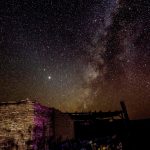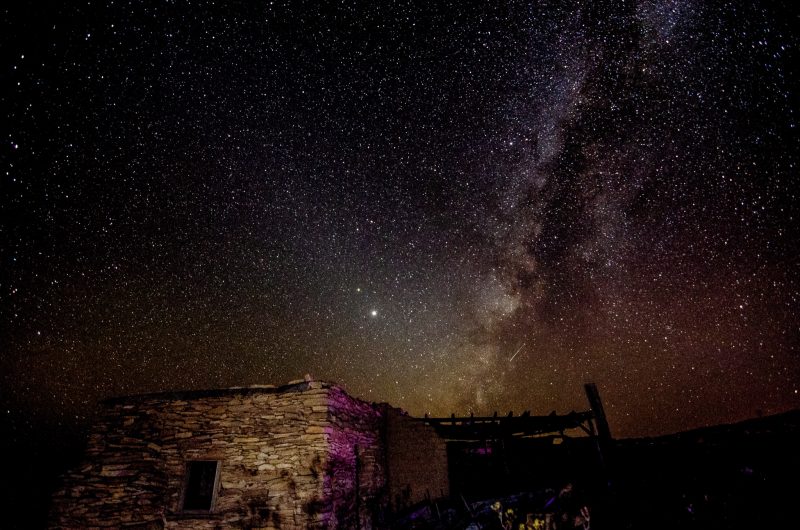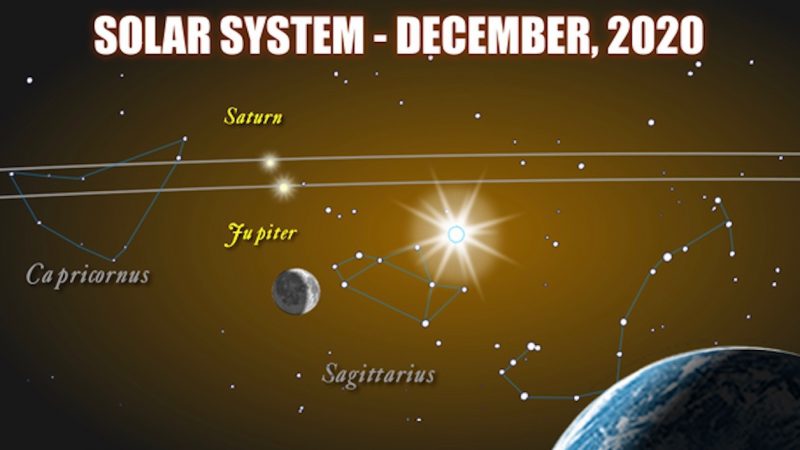

View at EarthSky Community Photos. | Michael Zuber caught Jupiter and Saturn – the 2 bright “stars” (really planets) above the building in this photo – from Terlingua, Texas, on November 11, 2020. You can’t miss these worlds in Earth’s sky now. Jupiter is the brighest starlike object up every evening! In a dark sky, as you can see, they are near the starry band of the Milky Way. Thank you, Michael.
Astronomers use the word conjunction to describe meetings of planets and other objects on our sky’s dome. They use the term great conjunction to describe meetings of the two biggest worlds in our solar system, mighty Jupiter and the glorious ringed planet Saturn. The next great conjunction of Jupiter and Saturn will be December 21, 2020. That date is, coincidentally, the date of the December solstice. It’ll be the first Jupiter-Saturn conjunction since the year 2000, and the closest Jupiter-Saturn conjunction since 1623, only 14 years after Galileo made his first telescope. At their closest, Jupiter and Saturn will be only 0.1 degree apart. That’s just 1/5 of a full moon diameter.
The extra-close Jupiter-Saturn conjunction in 2020 won’t be matched again until the Jupiter-Saturn conjunction of March 15, 2080.
But don’t wait until December to start watching these worlds. They’re visible tonight and every night – near each other for the rest of 2020 – an appealing and mind-expanding sight!
The 2021 lunar calendars are here! Order yours before they’re gone. Makes a great gift!
See photos: Jupiter and Saturn draw closer!

The moon has swung near Jupiter and Saturn in recent nights and will still be near them on November 20 and 21, 2020, too, as darkness falls. Read more.

In December, just as Jupiter and Saturn are nearly at their closest, the young moon will sweep past them. From December 16-25, 2020, the 2 will be separated by less than a full-moon diameter, just as the moon is passing close. Don’t miss this glorious sight in the western sky after sunset! Jupiter is brighter, outshining Saturn by 12 times. Saturn is respectably bright, shining as brilliantly as a 1st-magnitude star. Read more.
At the 2000 great conjunction, 20 years ago, Jupiter and Saturn were near the sun in our sky and difficult to observe. We’re due for a more observable great conjunction, and we’ll get one. In November, Jupiter and Saturn are noticeable for their nearness to each other, and they are in the sky when darkness falls.
By December, Jupiter and Saturn will still be easily visible. They’ll be, if anything, even more beautiful than now, in the western twilight shortly after sunset.
You’ll recognize Jupiter and Saturn easily, from now through the end of the year. Jupiter is brighter than any star. Saturn is not as bright as Jupiter, but it’s as bright as the brightest stars and shines with a distinctly golden color. Also, Jupiter is near Saturn! Saturn is just to the east of Jupiter on the sky’s dome. Unlike the twinkling stars, Jupiter and Saturn both shine steadily.
This month – during the period when the moon swept past Jupiter and Saturn (about November 16 to November 21) – the two gas giant planets are some 3 degrees apart.
Over the coming month – from November 21 to the day of the conjunction itself, December 21 – Jupiter will travel about 6 degrees and Saturn 3 degrees on the sky’s dome. That movement will mean that Jupiter bridges the 3-degree gap between itself and Saturn.
Bingo! Great conjunction!

Artist’s concept of Jupiter and Saturn in December of 2020, as viewed from a space-based perspective. Their conjunction will be December 21. See the moon in this drawing? It’ll be along our line of sight to the planets around December 16, 2020. Chart via Jay Ryan at ClassicalAstronomy.com.
Saturn, the sixth planet outward from the sun, is the farthest and slowest-moving planet that we can easily see with the eye alone. Dazzling Jupiter, the fifth planet outward from the sun, is the second-slowest bright planet, after Saturn.
For that reason, Jupiter/Saturn conjunctions are the rarest of bright-planet conjunctions, by virtue of their slow motions in front of the constellations of the zodiac. Saturn takes nearly 30 years to go around the sun full circle whereas Jupiter takes nearly 12 years.
Thus, every 20 years, Jupiter catches up to Saturn as viewed from Earth.
From the years 2000 to 2100 inclusive, as viewed from our planet Earth, these Jupiter/Saturn conjunctions (in ecliptic longitude) happen on these dates:
May 28, 2000
December 21, 2020
October 31, 2040
April 7, 2060
March 15, 2080
September 18, 2100

View larger. | Here’s a telescopic view of how Jupiter and Saturn will look in the evening sky December 21, 2020. On the evening of closest approach on December 21, 2020, they will look like a double planet, separated by only 1/5th the diameter of the full moon. For most telescope viewers, each planet and several of their largest moons will be visible in the same field of view that evening. Image via Rice University.
Now, here’s why these great Jupiter/Saturn conjunctions happen every 20 years. Each year, Saturn completes about 12 degrees of its orbit around the sun, whereas Jupiter completes about 30 degrees. Therefore, in one year, Jupiter closes the gap between itself and Saturn by about 18 degrees (30 – 12 = 18 degrees).
In a period of 20 years, then, Jupiter gains 360 degrees on Saturn (18 x 20 = 360 degrees), therefore lapping the ringed planet once every 20 years.
So start watching Jupiter and Saturn now! And mark your calendar for the great conjunction of Jupiter and Saturn on December 21, 2020.

View at EarthSky Community Photos. | As you gaze toward Jupiter and Saturn in the night sky, imagine a 3rd planet near them, invisible to the eye and even to some small telescopes. Joel Weatherly of Edmonton, Aberta, Canada, captured this image. He wrote, “Autumn’s lengthening nights offer an excellent opportunity to explore the sky before it gets too cold. Planets such as Jupiter and Saturn have been highlights of the night, but the accompanying starfield is worth a gander as well. Pluto isn’t visible in this image, but that’s where it was hanging out.” Thank you, Joel! Read more about the triple conjunction of Jupiter and Pluto in 2020.
Bottom line: The coming great conjunction of Jupiter and Saturn will be December 21, 2020, the day of the December solstice. These two worlds will be closer in our sky than they’ve been since 1623. At their closest, Jupiter and Saturn will be only 0.1 degree apart. That’s just 1/5 of a full moon diameter. Charts and more info here.
from EarthSky https://ift.tt/2WVmFCm


View at EarthSky Community Photos. | Michael Zuber caught Jupiter and Saturn – the 2 bright “stars” (really planets) above the building in this photo – from Terlingua, Texas, on November 11, 2020. You can’t miss these worlds in Earth’s sky now. Jupiter is the brighest starlike object up every evening! In a dark sky, as you can see, they are near the starry band of the Milky Way. Thank you, Michael.
Astronomers use the word conjunction to describe meetings of planets and other objects on our sky’s dome. They use the term great conjunction to describe meetings of the two biggest worlds in our solar system, mighty Jupiter and the glorious ringed planet Saturn. The next great conjunction of Jupiter and Saturn will be December 21, 2020. That date is, coincidentally, the date of the December solstice. It’ll be the first Jupiter-Saturn conjunction since the year 2000, and the closest Jupiter-Saturn conjunction since 1623, only 14 years after Galileo made his first telescope. At their closest, Jupiter and Saturn will be only 0.1 degree apart. That’s just 1/5 of a full moon diameter.
The extra-close Jupiter-Saturn conjunction in 2020 won’t be matched again until the Jupiter-Saturn conjunction of March 15, 2080.
But don’t wait until December to start watching these worlds. They’re visible tonight and every night – near each other for the rest of 2020 – an appealing and mind-expanding sight!
The 2021 lunar calendars are here! Order yours before they’re gone. Makes a great gift!
See photos: Jupiter and Saturn draw closer!

The moon has swung near Jupiter and Saturn in recent nights and will still be near them on November 20 and 21, 2020, too, as darkness falls. Read more.

In December, just as Jupiter and Saturn are nearly at their closest, the young moon will sweep past them. From December 16-25, 2020, the 2 will be separated by less than a full-moon diameter, just as the moon is passing close. Don’t miss this glorious sight in the western sky after sunset! Jupiter is brighter, outshining Saturn by 12 times. Saturn is respectably bright, shining as brilliantly as a 1st-magnitude star. Read more.
At the 2000 great conjunction, 20 years ago, Jupiter and Saturn were near the sun in our sky and difficult to observe. We’re due for a more observable great conjunction, and we’ll get one. In November, Jupiter and Saturn are noticeable for their nearness to each other, and they are in the sky when darkness falls.
By December, Jupiter and Saturn will still be easily visible. They’ll be, if anything, even more beautiful than now, in the western twilight shortly after sunset.
You’ll recognize Jupiter and Saturn easily, from now through the end of the year. Jupiter is brighter than any star. Saturn is not as bright as Jupiter, but it’s as bright as the brightest stars and shines with a distinctly golden color. Also, Jupiter is near Saturn! Saturn is just to the east of Jupiter on the sky’s dome. Unlike the twinkling stars, Jupiter and Saturn both shine steadily.
This month – during the period when the moon swept past Jupiter and Saturn (about November 16 to November 21) – the two gas giant planets are some 3 degrees apart.
Over the coming month – from November 21 to the day of the conjunction itself, December 21 – Jupiter will travel about 6 degrees and Saturn 3 degrees on the sky’s dome. That movement will mean that Jupiter bridges the 3-degree gap between itself and Saturn.
Bingo! Great conjunction!

Artist’s concept of Jupiter and Saturn in December of 2020, as viewed from a space-based perspective. Their conjunction will be December 21. See the moon in this drawing? It’ll be along our line of sight to the planets around December 16, 2020. Chart via Jay Ryan at ClassicalAstronomy.com.
Saturn, the sixth planet outward from the sun, is the farthest and slowest-moving planet that we can easily see with the eye alone. Dazzling Jupiter, the fifth planet outward from the sun, is the second-slowest bright planet, after Saturn.
For that reason, Jupiter/Saturn conjunctions are the rarest of bright-planet conjunctions, by virtue of their slow motions in front of the constellations of the zodiac. Saturn takes nearly 30 years to go around the sun full circle whereas Jupiter takes nearly 12 years.
Thus, every 20 years, Jupiter catches up to Saturn as viewed from Earth.
From the years 2000 to 2100 inclusive, as viewed from our planet Earth, these Jupiter/Saturn conjunctions (in ecliptic longitude) happen on these dates:
May 28, 2000
December 21, 2020
October 31, 2040
April 7, 2060
March 15, 2080
September 18, 2100

View larger. | Here’s a telescopic view of how Jupiter and Saturn will look in the evening sky December 21, 2020. On the evening of closest approach on December 21, 2020, they will look like a double planet, separated by only 1/5th the diameter of the full moon. For most telescope viewers, each planet and several of their largest moons will be visible in the same field of view that evening. Image via Rice University.
Now, here’s why these great Jupiter/Saturn conjunctions happen every 20 years. Each year, Saturn completes about 12 degrees of its orbit around the sun, whereas Jupiter completes about 30 degrees. Therefore, in one year, Jupiter closes the gap between itself and Saturn by about 18 degrees (30 – 12 = 18 degrees).
In a period of 20 years, then, Jupiter gains 360 degrees on Saturn (18 x 20 = 360 degrees), therefore lapping the ringed planet once every 20 years.
So start watching Jupiter and Saturn now! And mark your calendar for the great conjunction of Jupiter and Saturn on December 21, 2020.

View at EarthSky Community Photos. | As you gaze toward Jupiter and Saturn in the night sky, imagine a 3rd planet near them, invisible to the eye and even to some small telescopes. Joel Weatherly of Edmonton, Aberta, Canada, captured this image. He wrote, “Autumn’s lengthening nights offer an excellent opportunity to explore the sky before it gets too cold. Planets such as Jupiter and Saturn have been highlights of the night, but the accompanying starfield is worth a gander as well. Pluto isn’t visible in this image, but that’s where it was hanging out.” Thank you, Joel! Read more about the triple conjunction of Jupiter and Pluto in 2020.
Bottom line: The coming great conjunction of Jupiter and Saturn will be December 21, 2020, the day of the December solstice. These two worlds will be closer in our sky than they’ve been since 1623. At their closest, Jupiter and Saturn will be only 0.1 degree apart. That’s just 1/5 of a full moon diameter. Charts and more info here.
from EarthSky https://ift.tt/2WVmFCm

Aucun commentaire:
Enregistrer un commentaire